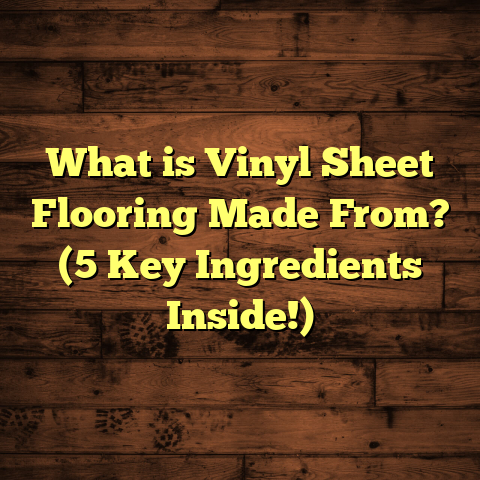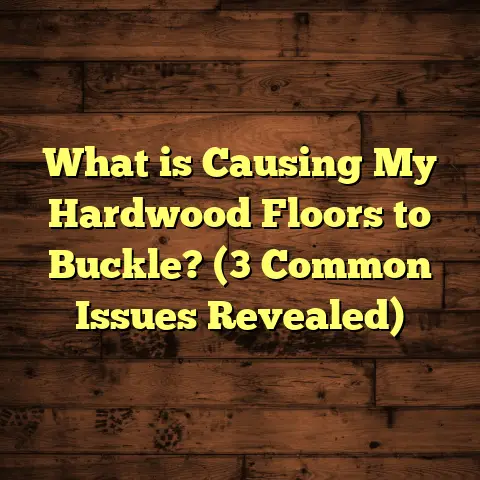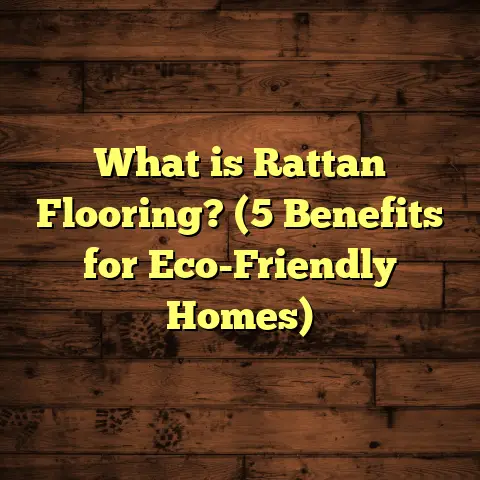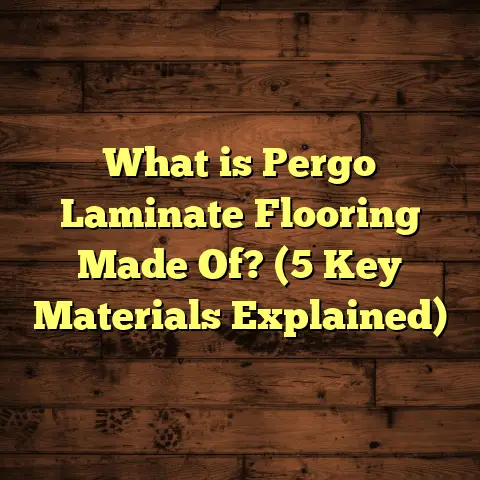What is LVT Flooring in the UK? (5 Key Benefits Explained!)
Durability is what first got me hooked on LVT flooring— not just because it looks great but because it stands the test of time.
If you’ve ever struggled with floors that scratch easily or warp after a spill, you’ll appreciate how resilient LVT is. Over the years, I’ve installed it in many homes and commercial spaces across the UK, seeing firsthand how it balances beauty with practicality. It’s a flooring solution that doesn’t just promise good looks but delivers lasting performance, which is exactly why it’s become so popular.
Want to know exactly what LVT flooring is, why it’s such a solid choice, and how to get the most out of it? Let me break it down for you, sharing my personal stories, real data, and practical tips along the way.
What is LVT Flooring?
Luxury Vinyl Tile (LVT) is a type of vinyl flooring designed to mimic natural materials like wood, stone, or ceramic tiles. But it’s not your average vinyl — it’s luxury vinyl because of its high-quality design and construction that make it look convincingly like real hardwood or stone.
LVT typically comes in planks or tiles, giving you flexibility in how you lay it out. Unlike traditional vinyl sheets that come in large rolls, these individual pieces are easier to handle and install.
The Structure of LVT
Understanding what makes LVT so durable means looking at its layers:
- Wear Layer: This is a transparent layer on top which protects the floor from scratches, scuffs, and stains. The thickness and quality of this layer directly affect how long your floor will last.
- Design Layer: This is where the magic happens. A high-definition photographic layer replicates wood grain, stone veining, or tile patterns in stunning detail.
- Core Layer: The core gives the floor its stability and strength. Some LVT products have a rigid core for extra durability and resistance to dents.
- Backing Layer: This layer adds support and moisture resistance.
Because of this layered construction, LVT can hold up against impacts and moisture better than many traditional flooring options.
My Personal Experience With LVT
Years ago, I worked on renovating a Victorian terrace where the original wooden floors were beyond repair. The client loved the look of aged oak but wanted something more practical for their young family. We installed oak-look LVT planks throughout the living room and kitchen.
What stood out immediately was how realistic the texture felt underfoot. Visitors often commented that they couldn’t tell it wasn’t real wood until they looked closely. After two years—and plenty of toddler chaos—the floors still look amazing. No scratches, no warping, just easy cleaning and consistent performance.
5 Key Benefits of LVT Flooring
1. Durability That Holds Up Over Time
LVT’s durability is one of its biggest selling points. The wear layer protects against everyday hazards like scratches from shoes or pet claws. In fact, according to industry testing standards such as the Taber Abrasion Test, LVT with a wear layer thickness of 0.3 mm or more can withstand over 2,000 cycles of abrasion before showing wear.
This means in practical terms:
- High foot traffic areas like hallways and kitchens stay looking new longer.
- It resists dents from dropped objects better than softer woods.
- It handles pets well without claw marks ruining the surface.
In my experience, many customers are shocked at how well LVT takes a beating compared to traditional hardwood or laminate floors.
2. Water Resistance Ideal for UK Weather
The UK’s damp climate can be tough on flooring. Traditional hardwood can swell or warp when exposed to moisture. LVT shines here because it’s virtually waterproof.
The vinyl composition and tight seams prevent water from seeping through. This makes LVT perfect for:
- Bathrooms and kitchens where splashes happen regularly.
- Basements prone to dampness.
- Entryways where wet shoes bring water inside.
I remember a client who spilled red wine in their kitchen—on a hardwood floor this would have been a nightmare—but with LVT, a quick wipe-up was all it took with zero staining or damage.
3. Quick and Easy Installation Saves Money
From a contractor’s perspective, LVT is straightforward to install, which keeps project timelines short and reduces labor costs.
There are different installation methods:
- Click-Lock Systems: Tiles snap together easily without glue.
- Glue-Down: Adhesive applied to subfloor before laying tiles.
- Loose Lay: Tiles stay put by friction and weight; great for rentals or temporary setups.
Because you don’t need grout like with ceramic tiles or nails like hardwood, installation is simpler and cleaner. A typical 20m² room can be done in a day or two by an experienced installer.
For DIY enthusiasts, click-lock LVT is especially appealing because it doesn’t require special tools or professional skills.
4. Low Maintenance—Spend Less Time Cleaning
Keeping floors looking good is always a concern. I’ve seen clients maintain hardwood floors beautifully, but it takes effort—sanding, polishing, refinishing.
With LVT, maintenance is easy:
- Regular sweeping or vacuuming removes dirt that could scratch.
- Damp mopping with mild cleaners keeps surfaces bright.
- No waxing or sealing needed.
- Immediate clean-up of spills prevents staining.
This simplicity makes LVT a favourite among busy households or commercial spaces where cleaning time is limited.
5. Stylish Designs for Every Taste
You don’t have to sacrifice style for practicality with LVT. Thanks to advances in printing technology, you can find LVT that mimics almost any natural flooring:
- Oak, walnut, maple wood grains
- Slate, marble, granite stone effects
- Patterned tiles resembling encaustic cement designs
I’ve used marble-effect LVT in bathrooms to achieve an elegant look without the cold feel of real stone. In other projects, I’ve matched oak-look planks perfectly with existing furniture styles.
The variety means you can tailor your floors to suit modern minimalism or classic country charm alike.
How Much Does LVT Flooring Cost in the UK?
Understanding costs up front helps avoid surprises later. Here’s what I’ve seen recently for typical UK prices (2024 data):
| Type | Material Cost per m² | Installation Cost per m² | Total Average Cost per m² |
|---|---|---|---|
| Residential Grade LVT | £15 – £30 | £10 – £20 | £25 – £50 |
| Commercial Grade LVT | £25 – £40 | £15 – £25 | £40 – £65 |
| High-End Designer LVT | £30 – £45 | £15 – £25 | £45 – £70 |
For comparison:
- Hardwood flooring can cost between £40 – £80+ per m² installed.
- Laminate flooring averages around £20 – £35 per m² installed.
- Ceramic tile prices vary widely but often fall between £30 – £50 per m² installed.
These numbers show LVT offers a competitive balance between price and premium appearance/durability.
Installation Tips from My Experience
Preparing Your Subfloor Matters
Before laying any flooring, preparation is key. I always make sure the subfloor is:
- Clean and free from dust or debris
- Levelled (uneven surfaces can cause tiles to crack or shift)
- Dry (moisture could cause adhesive failures)
If you’re installing over concrete or existing vinyl, sometimes a self-leveling compound may be necessary.
Acclimatize Your Flooring
LVT needs time to settle into your home environment — usually 24 to 48 hours at room temperature — before installation begins. This prevents expansion or contraction problems later on.
Layout Planning
I recommend planning your pattern carefully, especially if you want to create herringbone or diagonal layouts. Measuring your room and calculating cuts ahead minimizes waste and keeps installation smooth.
Installing Click-Lock Flooring
If you’re going DIY with click-lock planks:
- Start along the longest wall.
- Click each plank securely into place.
- Leave a small expansion gap (around 8-10mm) at edges for natural material movement.
- Use spacers to maintain consistent gaps during installation.
Glue-Down Installation
For glue-down LVT:
- Spread adhesive evenly with recommended trowel size.
- Lay tiles carefully ensuring no air bubbles remain.
- Roll the floor with a roller for good adhesion.
Maintaining Your LVT Floors Over Time
Daily Care
A simple broom or vacuum with soft bristles removes grit that could scratch the surface. For wet cleaning:
- Use warm water with a mild detergent.
- Avoid bleach or ammonia-based cleaners as they can dull the finish.
Preventing Damage
Furniture pads on chair legs prevent dents. Avoid dragging heavy furniture across floors without protection.
If you have pets like I do—two lively dogs—check their nails regularly to reduce scratching risks.
Repairing Minor Damage
One big advantage: if a tile gets damaged, you can replace that section rather than redo the entire floor. Keep extra tiles from your original purchase for this purpose.
Environmental Considerations of LVT Flooring
Sustainability matters more now than ever. Vinyl flooring has sometimes gotten criticism for environmental impact because it’s a plastic product.
But manufacturers are improving:
- Many brands now offer recyclable options.
- Low VOC (volatile organic compounds) emissions mean better indoor air quality.
- Some use recycled content in production.
If environmental impact is a priority for you, research brands carefully and ask suppliers about certifications such as FloorScore or GREENGUARD.
Case Study: Transforming a Family Home with LVT
A few years back, I worked with a family in Manchester who wanted durable floors for their open-plan kitchen/dining/living area.
They had three energetic kids and two dogs—so durability was non-negotiable—but they didn’t want anything that looked too ‘plastic’.
We chose an oak-look LVT plank with a textured surface for grip and authentic feel. Installation took just two days thanks to the click-lock system.
One year later:
- The floors had zero scratches despite heavy day-to-day activity.
- Cleaning was quick and hassle-free.
- The family loved how warm and inviting the space felt with wood-look floors without worries about water damage from spills or muddy paw prints.
Common Questions About LVT Flooring
Is LVT Flooring Comfortable Underfoot?
Yes! Most people find it softer than ceramic tile and warmer than stone or hardwood because vinyl has some give. Some products include an underlay layer which adds cushioning and sound insulation—something I always recommend in bedrooms or living rooms.
Can I Install LVT Over Existing Floors?
Often yes—if your current floor is flat and stable (like vinyl sheet or ceramic tile), you can lay LVT directly over it. This saves time and mess from removing old flooring.
How Long Does LVT Flooring Last?
With proper care, well-made LVT can last 15 to 20 years or more. The wear layer thickness is key: thicker layers mean longer life expectancy.
Final Thoughts on Choosing LVT Flooring in the UK
If you want floors that combine durability, water resistance, style, ease of installation, and low maintenance, then Luxury Vinyl Tile is definitely worth serious consideration.
From my years working with various materials across countless projects—from cozy family homes to busy commercial spaces—I’ve seen how dependable LVT can be when chosen wisely and installed correctly.
Whether you’re renovating an old property or fitting out new builds across the UK, this flooring offers excellent value without compromising on appearance or performance.
If you want me to help you choose specific products or provide advice on installation methods tailored to your project—just let me know! I’m here to share everything I’ve learned so you get floors that look amazing and last for years.
Thank you for reading this far! Got any questions about your project? Feel free to ask—I love chatting about flooring.





